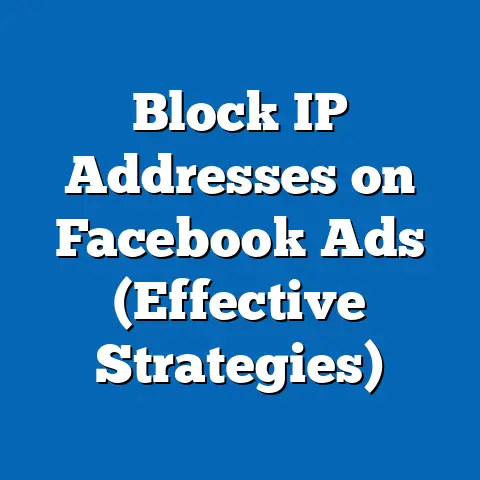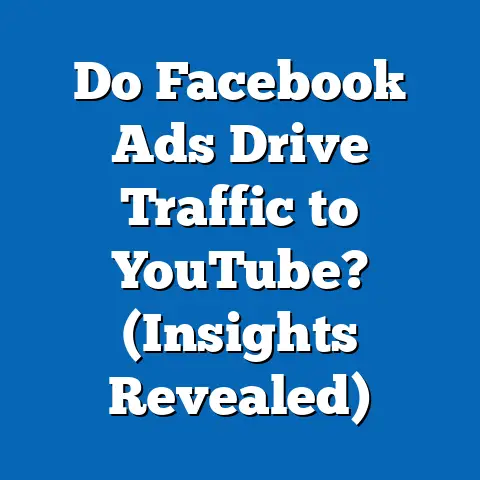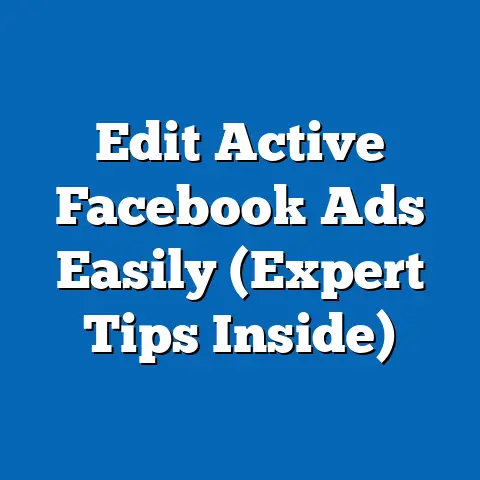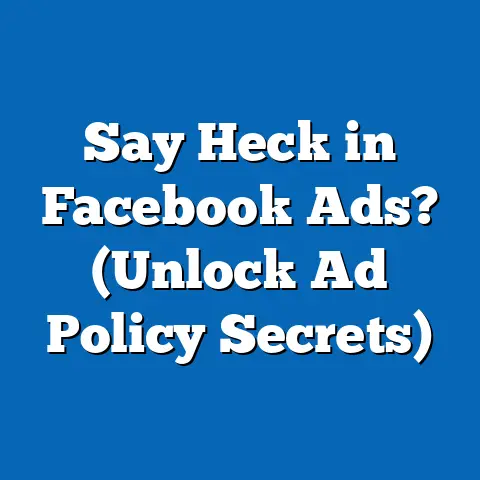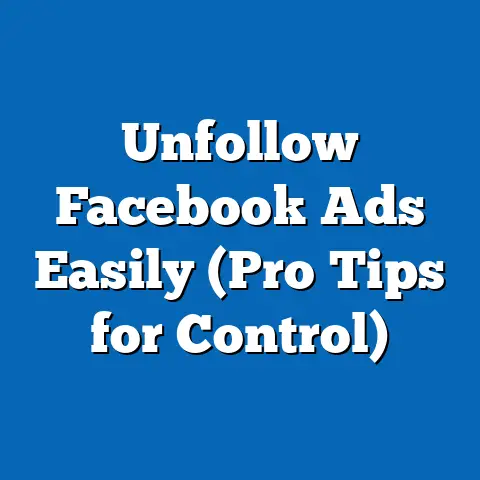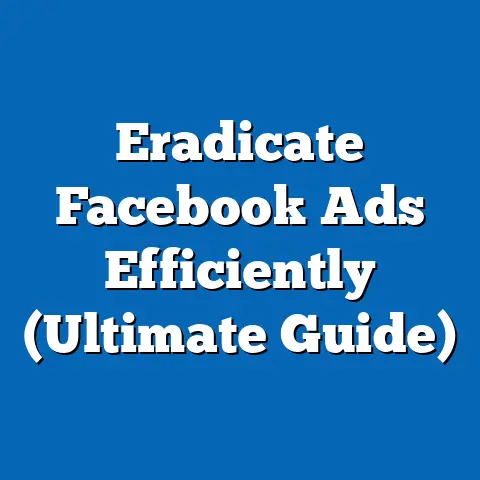Create Irresistible Facebook Video Ads (Expert Strategies)
In the rapidly evolving world of digital marketing, safety—both in terms of data privacy and brand reputation—remains a cornerstone of successful advertising campaigns. As businesses increasingly turn to platforms like Facebook to reach vast audiences through video ads, ensuring a safe and trustworthy environment for users and advertisers alike is paramount. This report begins by addressing safety concerns in digital advertising before delving into expert strategies for creating irresistible Facebook video ads.
Safety in digital advertising encompasses protecting user data, preventing fraudulent ad practices, and maintaining brand integrity in a highly competitive online space. With over 2.9 billion monthly active users on Facebook as of 2023 (Statista, 2023), the platform is a prime target for both legitimate businesses and malicious actors. This section explores current data on safety issues, projects future trends, and identifies key factors driving changes in the digital advertising safety landscape.
Section 1: Safety in Digital Advertising – Current Data and Challenges
Current Landscape of Safety Concerns
Recent studies reveal that digital ad fraud costs the global advertising industry approximately $84 billion annually, with a significant portion affecting social media platforms like Facebook (Juniper Research, 2023). Common issues include click fraud, where bots or fake accounts inflate engagement metrics, and ad misrepresentation, where ads are placed in unsafe or irrelevant contexts. Furthermore, data privacy breaches have heightened user distrust, with 74% of consumers expressing concern over how their personal information is used in targeted advertising (Pew Research Center, 2022).
Facebook has faced scrutiny over its handling of user data, particularly following high-profile incidents like the Cambridge Analytica scandal in 2018. Despite implementing stricter privacy policies and transparency tools, such as the Ad Library, challenges persist. For advertisers, ensuring that their campaigns are not associated with harmful content or misinformation is critical to maintaining brand trust.
Key Factors Driving Safety Issues
Several factors contribute to safety challenges in digital advertising. First, the sheer volume of content on platforms like Facebook—billions of posts and ads daily—makes comprehensive moderation difficult. Second, the sophistication of ad fraud schemes has increased, with bad actors leveraging AI to mimic genuine user behavior (Forbes, 2023). Finally, evolving regulations, such as the European Union’s General Data Protection Regulation (GDPR) and the California Consumer Privacy Act (CCPA), place additional compliance burdens on advertisers and platforms.
Section 2: Projected Trends in Digital Advertising Safety
Trend 1: Increased Use of AI for Fraud Detection
Looking ahead, AI and machine learning are expected to play a larger role in detecting and preventing ad fraud. According to projections by eMarketer (2023), investments in AI-driven ad verification tools will grow by 25% annually through 2027. However, as fraud detection improves, so too will the tactics of malicious actors, creating an ongoing technological arms race.
Trend 2: Stricter Privacy Regulations
Regulatory frameworks are likely to become more stringent over the next decade. By 2030, it is projected that over 75% of global internet users will be covered by comprehensive data privacy laws (Gartner, 2023). For advertisers on Facebook, this means adapting to reduced access to user data for targeting, necessitating a shift toward contextual advertising and first-party data collection.
Trend 3: Brand Safety Tools
Brand safety—ensuring ads do not appear alongside harmful or controversial content—will remain a priority. Tools like Facebook’s Brand Safety Controls, which allow advertisers to exclude certain content categories, are expected to become more sophisticated. However, limitations in content moderation accuracy may persist, with false positives and negatives affecting campaign performance.
Methodological Note on Projections
These trends are based on linear extrapolation of current investment data, regulatory developments, and technological adoption rates. However, unforeseen geopolitical events or major data breaches could accelerate or alter these trajectories. The projections assume continued growth in digital ad spending, which may not hold in the event of a global economic downturn.
Section 3: Key Factors Driving Changes in Safety
Technological Advancements
The rapid development of AI and blockchain technologies offers both opportunities and challenges for safety in digital advertising. While AI can enhance fraud detection, it also enables more sophisticated scams. Blockchain-based ad verification systems, though still in early stages, could provide transparent tracking of ad impressions and clicks by 2028 (Deloitte, 2023).
User Behavior and Expectations
As users become more aware of privacy issues, their demand for transparency and control over data usage will shape advertising practices. Surveys indicate that 68% of social media users are more likely to engage with brands that prioritize ethical data practices (Edelman Trust Barometer, 2023). This trend pressures platforms like Facebook to balance user trust with advertiser needs.
Regulatory Environment
Government policies will continue to influence safety standards. The potential for global harmonization of privacy laws remains uncertain, creating a patchwork of compliance requirements. Advertisers must stay agile to navigate these changes, particularly as fines for non-compliance increase.
Section 4: Transition to Creating Irresistible Facebook Video Ads
Having established the critical role of safety in digital advertising, the remainder of this report focuses on actionable strategies for crafting compelling Facebook video ads. While safety forms the foundation of trust, creativity and data-driven techniques are the keys to capturing audience attention. The following sections outline expert strategies, supported by current data and case studies, to maximize engagement and conversion rates.
Section 5: Understanding the Power of Video Ads on Facebook
Why Video Ads Matter
Video content dominates social media engagement, with 85% of Facebook users watching videos daily (HubSpot, 2023). Video ads, in particular, generate 59% more engagement than static image ads (Social Media Today, 2023). This makes video a critical tool for brands seeking to stand out in crowded newsfeeds.
Key Metrics for Success
When creating video ads, advertisers should focus on metrics like view-through rate (VTR), click-through rate (CTR), and cost-per-acquisition (CPA). For instance, the average CTR for Facebook video ads in 2023 is 0.9%, though top-performing campaigns can achieve rates as high as 2.5% (WordStream, 2023). Understanding these benchmarks helps set realistic goals.
Visual Representation: Engagement Metrics for Video Ads
(Insert bar chart here comparing average CTR, VTR, and CPA for video ads versus static ads on Facebook, using 2023 data from WordStream and Social Media Today.)
Section 6: Expert Strategies for Irresistible Facebook Video Ads
Strategy 1: Hook Within the First 3 Seconds
Attention spans on social media are short, with 65% of users deciding whether to watch a video within the first 3 seconds (Facebook Business, 2023). Start with a visually striking image, a bold question, or an unexpected sound to grab attention. For example, a fitness brand might open with a dramatic before-and-after transformation shot.
Strategy 2: Optimize for Mobile Viewing
Over 90% of Facebook users access the platform via mobile devices (Statista, 2023). Design videos with vertical or square formats (9:16 or 1:1 aspect ratios) to maximize screen real estate. Additionally, include captions, as 85% of videos are watched on mute (Verizon Media, 2023).
Strategy 3: Leverage Storytelling
Emotional storytelling can increase ad recall by 31% compared to purely informational content (Nielsen, 2023). Craft a narrative that resonates with your target audience’s values or pain points. A pet food brand, for instance, might tell a heartwarming story of a rescued dog finding a loving home.
Strategy 4: Use Strong Calls-to-Action (CTAs)
A clear CTA can boost conversion rates by up to 20% (HubSpot, 2023). Whether it’s “Shop Now,” “Learn More,” or “Sign Up,” ensure the CTA is visually prominent and aligns with the ad’s objective. Test multiple CTAs to identify what resonates best with your audience.
Strategy 5: Test and Iterate with A/B Testing
A/B testing different video elements—such as thumbnails, headlines, and lengths—can improve performance by identifying what works best. Data shows that brands running regular A/B tests see a 15% higher ROI on ad spend (Optimizely, 2023). Use Facebook’s built-in testing tools to experiment systematically.
Visual Representation: Impact of Storytelling on Ad Recall
(Insert line graph here showing the correlation between emotional storytelling elements and ad recall rates, based on 2023 Nielsen data.)
Section 7: Scenarios for Future Success in Facebook Video Ads
Scenario 1: Increased Reliance on AI Personalization
If AI-driven targeting continues to evolve within privacy constraints, video ads could become hyper-personalized, improving engagement by 30% by 2027 (eMarketer, 2023). However, this depends on platforms like Facebook balancing personalization with user consent.
Scenario 2: Shift to Short-Form Content Dominance
With the rise of platforms like TikTok, short-form video content (under 15 seconds) may dominate Facebook ad strategies. Projections suggest that by 2025, 70% of video ad budgets will focus on short-form formats (Forrester, 2023). Brands must adapt by prioritizing quick, impactful messaging.
Scenario 3: Regulatory Constraints Limit Targeting
If privacy laws further restrict data usage, advertisers may see a 20% drop in targeting accuracy (Gartner, 2023). In this scenario, contextual advertising—placing ads based on content rather than user data—will become critical. Brands should prepare by aligning video content with relevant topics and communities.
Methodological Note on Scenarios
These scenarios are constructed using trend analysis and expert forecasts from industry reports. They assume stable platform growth and user behavior trends, though sudden shifts in technology or policy could alter outcomes. Each scenario carries inherent uncertainties, particularly regarding user adoption of new formats.
Section 8: Historical and Social Context of Video Advertising
Video advertising on social media has evolved significantly since Facebook introduced autoplay ads in 2013. Initially met with skepticism, video ads have become a dominant format due to changing user preferences for visual content and advancements in mobile technology. The rise of influencer marketing and user-generated content has further shaped how brands approach video storytelling.
Socially, video ads reflect broader cultural trends, such as the demand for authenticity and diversity in marketing. Campaigns that fail to align with these values risk backlash, as seen in several high-profile ad controversies over the past decade. Understanding this context helps advertisers craft messages that resonate while avoiding missteps.
Section 9: Limitations and Uncertainties in Data
While this report draws on reputable sources like Statista, eMarketer, and Nielsen, data on digital advertising—particularly fraud and user behavior—often relies on self-reported metrics or limited samples. Projections are inherently uncertain due to variables like economic conditions, technological disruptions, and regulatory changes. Additionally, platform-specific data from Facebook is sometimes opaque, limiting the depth of analysis.
Section 10: Conclusion and Recommendations
Creating irresistible Facebook video ads requires a dual focus on safety and creativity. Advertisers must prioritize data privacy, brand safety, and fraud prevention to build trust, while employing expert strategies like storytelling, mobile optimization, and A/B testing to drive engagement. Future scenarios suggest a dynamic landscape, with AI, short-form content, and regulatory shifts shaping ad strategies.
Recommendations for Advertisers:
1. Invest in AI tools for fraud detection and ad optimization.
2. Design mobile-first video content with captions and vertical formats.
3. Focus on emotional storytelling and strong CTAs to boost recall and conversions.
4. Prepare for privacy-driven changes by exploring contextual advertising.
5. Continuously test and iterate campaigns using data-driven insights.
By balancing safety with innovation, brands can harness the power of Facebook video ads to achieve lasting impact in a competitive digital marketplace.
References
– Statista (2023). Facebook Monthly Active Users.
– Juniper Research (2023). Global Ad Fraud Report.
– Pew Research Center (2022). Consumer Privacy Concerns.
– eMarketer (2023). AI in Advertising Forecast.
– Gartner (2023). Data Privacy Law Projections.
– HubSpot (2023). Video Engagement Statistics.
– Social Media Today (2023). Ad Format Performance Report.
– WordStream (2023). Facebook Ad Benchmarks.
– Forbes (2023). AI in Ad Fraud Schemes.
– Deloitte (2023). Blockchain in Advertising.
– Edelman Trust Barometer (2023). Consumer Trust in Brands.
– Nielsen (2023). Emotional Storytelling Impact.
– Optimizely (2023). A/B Testing ROI Report.
– Forrester (2023). Short-Form Video Trends.

